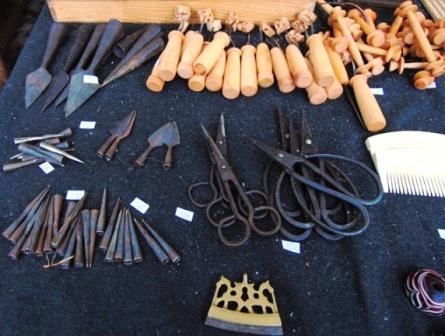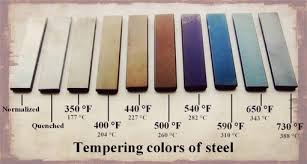is the heat treatment of a hardened material (metal, glass) in order to separate carbon in the form of graphite. The material is heated to a temperature below the transformation point, and then cooled down regulated in order to change its hardness, strength or flexibility.
 After hardening, the steel must be annealed, otherwise it is too brittle. By tempering the steel is less hard, but much tougher. For this purpose, the piece is re- heated, and depending on the alloy used and the desired hardness for some time held at ± 180 to 650 degrees C. You can e.g. leave it easily in a bread oven for one hour at 200°C. Thereafter, it is slowly cooled, usually to the air, to room temperature.
After hardening, the steel must be annealed, otherwise it is too brittle. By tempering the steel is less hard, but much tougher. For this purpose, the piece is re- heated, and depending on the alloy used and the desired hardness for some time held at ± 180 to 650 degrees C. You can e.g. leave it easily in a bread oven for one hour at 200°C. Thereafter, it is slowly cooled, usually to the air, to room temperature.
This is usually repeated several times (to convert soft - left austenite as much as possible to martensite). This takes the stress out of steel which otherwise is as hard, but also as fragile as glass.
The temperature of steel you can judge by the color it gets. Each type of steel has its own color gamut. Following list approximates the colors for HSS reasonable. An experienced blacksmith sees and hears the differences.
|
Forging / hardening |
annealing color tool steel |
||||
|
Glow |
°C |
from |
to |
color |
|
|
dark brown |
550 |
200 |
220 |
white-yellow |
|
|
brown red |
610 |
220 |
230 |
straw yellow |
|
|
dark red |
650 |
230 |
240 |
golden |
|
|
dark cherry red |
740 |
240 |
250 |
tan |
|
|
cherry red |
790 |
250 |
260 |
brown red |
|
|
light cherry red |
850 |
260 |
270 |
red |
|
|
light red |
890 |
270 |
280 |
purpel |
|
|
orange |
950 |
280 |
290 |
violet |
|
|
yellow |
1050 |
290 |
300 |
darkblue |
|
|
yellowish white |
1200 |
300 |
320 |
cornflower blue |
|
|
white |
1350 |
320 |
340 |
light blue |
|
|
340 |
360 |
bluegrey |
|||
|
360 |
380 |
gray |
|||

